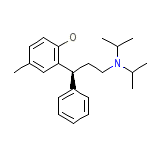Detrol




Detrol Brand names, Detrol Analogs
Detrol Brand Names Mixture
- No information avaliable
Detrol Chemical_Formula
C22H31NO
Detrol RX_link
http://www.rxlist.com/cgi/generic2/tolter.htm
Detrol fda sheet
Detrol msds (material safety sheet)
Detrol Synthesis Reference
No information avaliable
Detrol Molecular Weight
325.488 g/mol
Detrol Melting Point
No information avaliable
Detrol H2O Solubility
No information avaliable
Detrol State
Solid
Detrol LogP
6.076
Detrol Dosage Forms
Capsule (sustained-release)
Detrol Indication
For the treatment of overactive bladder (with symptoms of urinary frequency, urgency, or urge incontinence).
Detrol Pharmacology
Tolterodine is a competitive muscarinic receptor antagonist. Both urinary bladder contraction and salivation are mediated via cholinergic muscarinic receptors. After oral administration, tolterodine is metabolized in the liver, resulting in the formation of the 5-hydroxymethyl derivative, a major pharmacologically active metabolite. The 5-hydroxymethyl metabolite, which exhibits an antimuscarinic activity similar to that of tolterodine, contributes significantly to the therapeutic effect. Both tolterodine and the 5-hydroxymethyl metabolite exhibit a high specificity for muscarinic receptors, since both show negligible activity or affinity for other neurotransmitter receptors and other potential cellular targets, such as calcium channels. Tolterodine has a pronounced effect on bladder function. The main effects of tolterodine are an increase in residual urine, reflecting an incomplete emptying of the bladder, and a decrease in detrusor pressure, consistent with an antimuscarinic action on the lower urinary tract.
Detrol Absorption
No information avaliable
Detrol side effects and Toxicity
No information avaliable
Detrol Patient Information
No information avaliable
Detrol Organisms Affected
Humans and other mammals














